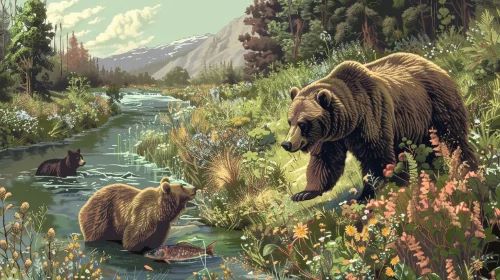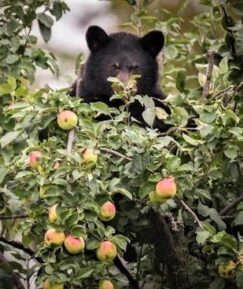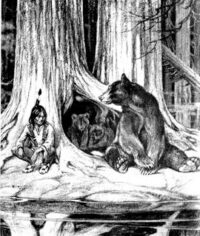Black Bear vs Grizzly Bear
Are black bears carnivores?
Are Grizzlies Carnivores? Nature’s Gourmets…

BLACK BEAR VS GRIZZLY BEAR: Are Grizzlies Carnivores? Nature’s Gourmets
Are bears carnivores? Except for Polar Bears, the answer is No.
Just like Humans, most bears are omnivorous. Some Black Bears are closer to being vegetarians than we are.
Just like us — like all animals — Bears have a close relationship with Food. But — Have you ever watched a Bear feeding? They seem to be really enjoying themselves. Nature’s Gourmets!
Sniffing berry plants. Rolling in sweet purple clover. Digging the shorelines for bugs and shellfish. Happily crunching on acorns — bears love acorns.
We once had a bear cub in one of our old apple trees. Don’t know where his Mama was. But the little fellow sure enjoyed that afternoon!
As an Old Cook, I really appreciate watching those furry foodies.
Here’s Lisa to tell us more…
“Feeding Habits of the Grizzly and Black Bear” A Guest Blog by Lisa Jeeves
Introduction: Discover the diverse and seasonal feeding habits of grizzly and black bears. They are crucial for wildlife enthusiasts for understanding bears in the forest. These majestic creatures, though classified as carnivores, primarily follow an omnivorous diet that changes with the seasons.
The Grizzly & Black Bear: Understanding Bear Diets Across Seasons
Bears have a varied diet that includes insects, fish, vegetation, berries, and smaller animals. Their feeding patterns are heavily influenced by the seasons, which in turn affects their behavior and habitat preferences.
Spring Feeding Patterns
After hibernation ends, food sources are scarce for grizzly and black bears. During spring, these bears often head to south-facing slopes, which receive more sunlight and thus have earlier plant growth. These areas may also have overwintered berries and winter-killed carcasses, providing crucial nutrition.
Wetlands near streams or other bodies of water are also key locations. Because vegetation sprouts earlier due to the moist soil. Here, bears might find sweet-vetch roots, glacier lily bulbs, and skunk cabbage. Occasionally, they may come across salmon carcasses. Which are a significant find because of their high protein content.
Summer: A Time of Plenty
As summer sets in, the landscape changes and food becomes more plentiful. Bears often frequent meadows, river edges, and marshes where greenery is abundant. Human developments such as parks, golf courses, and ski resorts also attract bears due to the accessible vegetation.
By mid-summer, bears start scavenging for insects like ants and beetle larvae. Early August marks the ripening of various berries such as huckleberries, blueberries, and buffalo berries, which are crucial due to their high-energy content.
Autumn: The Rush Before Winter
 Autumn is a critical feeding time as bears enter a phase called hyperphagia.
Autumn is a critical feeding time as bears enter a phase called hyperphagia.
Bears are attracted to apple trees because they are opportunistic eaters with a strong sense of smell. They enjoy fruit and berries, and apple trees are a popular source of food.
Black bears consume large amounts of food to accumulate fat for the winter. During this time, their movement increases, enhancing the chances of bruin sightings.
As the season progresses and frosts set in, fruit and berries become scarce. Prompting bears, especially those near coasts, to hunt for spawning fish. In areas without fish, bears focus on eating as much greenery and roots as possible.
Seasonal Shifts and Bear Sightings
The best times for bear sightings often correlate with these feeding patterns. For instance, during spring and autumn, when bears are actively searching for food, wildlife enthusiasts have higher chances of observing these animals. Tours during these times might focus on areas where food sources are abundant, increasing the likelihood of encounters.
Three Interesting Bear Stats and Facts
- According to the National Park Service, grizzly bears can eat up to 90 pounds of food each day during peak hyperphagia.
- Black bears have been observed to travel up to 40 miles in search of food during autumn.
- Studies have shown that the diet of black bears consists of up to 85% vegetative matter.
Understanding the feeding habits of grizzly and black bears enhances the experience of observing these magnificent creatures in their natural habitats. By aligning bear tours with these seasonal patterns, enthusiasts can increase their chances of memorable wildlife encounters.
Conclusion: “American black bears are omnivorous, meaning they will eat a variety of things, including both plants and meat. Their diet includes roots, berries, meat, fish, insects, larvae, grass, and other succulent plants.” To learn more, see National Wildlife Federation Wildlife Guide – Mammals Black Bear.
Where are grizzly bears located? How fast can a grizzly bear run? Brown bear vs grizzly bear, black bear vs grizzly bear. Bear feeding habits, seasonal feeding.
Did You Enjoy This Study of Wild Bears?
 If so, you’ve got to read my popular short story “THE BOY WHO WAS RAISED BY BEARS.” A Traditional Native American Animal Story & Folktale Retold.
If so, you’ve got to read my popular short story “THE BOY WHO WAS RAISED BY BEARS.” A Traditional Native American Animal Story & Folktale Retold.
Talking bears and human children adopted and raised by loving mama bears are common story themes in both Old and New World oral traditions. Even J R R Tolkien wrote about Beowulf and Bear’s Son Tales in European folklore.
“I loved this beautiful Animal Tale. Perfect!” Free to Read ==> CLICK HERE THE BOY WHO WAS RAISED BY BEARS
Thanks, Lisa, for your info. Lisa Jeeves is an accomplished Nature Writer based in London, England. She has been published on ArticlesFactory. Her articles include “Exploring the Pristine Snowshoe Trails of Courmayeur.” And “Galapagos Sea Lions: Sheep Dogs of the Ocean.” Source: Free Guest Posting Articles from ArticlesFactory.com.
Are Black Bears carnivores? How fast can a grizzly bear run? Brown bear vs grizzly bear. Bear feeding habits, seasonal feeding. Where are grizzly bears located?












